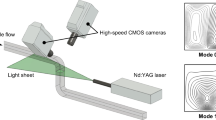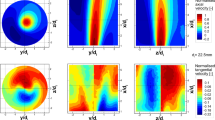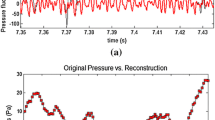Abstract
Spatio-temporal velocity fields of an axisymmetric sudden expansion were measured using an ultrasonic velocity profiler and analyzed to investigate the transitional scheme of the spatial structure using two-dimensional Fourier transform and proper orthogonal decomposition techniques. The variation of the zero-crossing point, the fluctuation energy directed upstream and the eigenmode spectrum all have the same transitional scheme as a function of the Reynolds number. The transitional scheme can be classified Re d<1,000 for the laminar regime, Re d=1,000–3,000 for the transitional regime and Re d>3,000 for the turbulent regime. Especially, in the transitional regime, we found large changes in the flow structure at Re d=1,500 and 2,000. The jump at Re d=2,000 is caused by the change in the flow condition upstream. The jump at Re d=1,500 clearly shows a change in the spatial structure of the flow.
















Similar content being viewed by others
References
Abe K, Kondoh T, Nagano Y (1994) A new turbulence model for predicting fluid flow and heat transfer in separating and reattaching flows—I. Flow field calculations. Int J Heat Mass Transfer 37:139–151
Adams EW, Johnston JP (1988) Effects of the separating shear layer on the reattachment flow structure. 2: Reattachment length and wall shear stress. Exp Fluids 6:493–499
Armly BF, Durst F, Pereira JCF, Schönung B (1983) Experimental and theoretical investigation of backward-facing step flow. J Fluid Mech 127:473–496
Aubry N, Chauve MP, Guyonnet R (1994) Transition to turbulence on rotating flat disk. Phys Fluids 6:2804–2814
Champeney DC (1973) Fourier transforms and their physical applications. Academic Press, London
Delville J, Bellin S, Bonnet JP (1990) Use of the proper orthogonal decomposition in a plane turbulent mixing layer. In: Metais O, Lesieur M (eds) Turbulence and Coherent Structures. Kluwer, Dordrecht, pp 75–90
Driver DM, Seegmiller HL, Marvin JG (1987) Time-dependent behavior of a reattachment shear layer. AIAA J 25:914–919
Eaton JK, Johnston JP (1981) A review of research on subsonic turbulent flow reattachment. AIAA J 19:1093–1100
Furuichi N, Hachiga T, Hishida K, Kumada M (2000) A flow structure at reattachment region of a two-dimensional backward-facing step by using advanced multi-point LDV. In: Adrian RJ, Durao DFG, Durst F, Heitor MV, Maeda M, Whitelaw JH (eds) Laser techniques applied to fluid mechanics. Springer, Berlin Heidelberg New York, pp 145–156
Hijikata K, Mimatsu J, Inoue J (1991) A study of wall pressure structure in a backward step flow by a holographic/velocity pressure cross-correlation visualization. In: Experimental and numerical flow visualization. ASME-FED 128: 61–68
Inoue Y, Yamashita S, Kondo K (2002) The ultrasonic velocity profile measurement of flow structure in the near field of a square free jet. Exp Fluids 32:170–178
Itoh T, Tsuji Y, Nakamura H, Kukita Y (2001) Application of ultrasonic velocity profile meter to vortex shedding and empirical eigenfunctional analysis. Exp Fluids 31:324–335
Lewis JP, Fletcher RH (1986) Limitations of the boundary-layer equations for predicting laminar symmetric sudden expansion. J Fluids Eng 108:208–213
Takeda Y (1991) Development of ultrasound velocity profile monitor. Nucl Eng Design 126:177–284
Takeda Y (1999) Quasi-periodic state and transition to turbulence in a rotating Couette system. J Fluid Mech 389:81–99
Teufel M, Trimis D, Lohmüller A, Takeda Y, Durst F (1992) Determination of velocity profiles in oscillating pipe flows by using laser Doppler velocimetry and ultrasonic measuring devices. Flow Measurement Instrum 3:95–101
Acknowledgement
The authors are grateful to Dr. G. King for his fruitful discussions and continuous encouragement.
Author information
Authors and Affiliations
Corresponding author
Rights and permissions
About this article
Cite this article
Furuichi, N., Takeda, Y. & Kumada, M. Spatial structure of the flow through an axisymmetric sudden expansion. Exp Fluids 34, 643–650 (2003). https://doi.org/10.1007/s00348-003-0612-2
Received:
Accepted:
Published:
Issue Date:
DOI: https://doi.org/10.1007/s00348-003-0612-2




